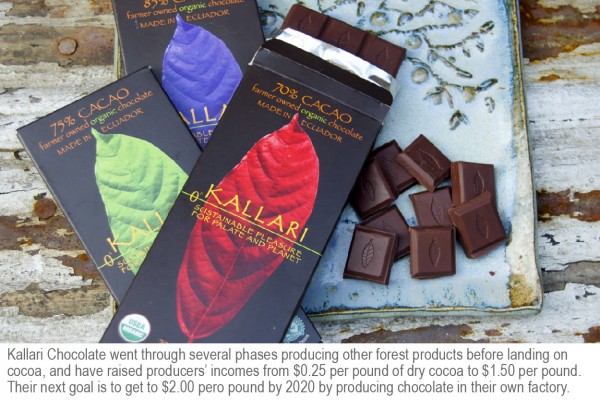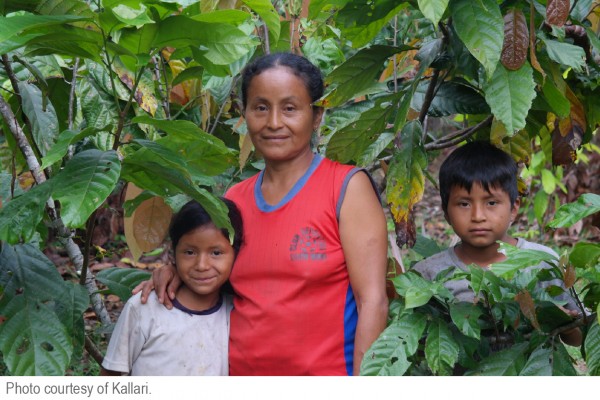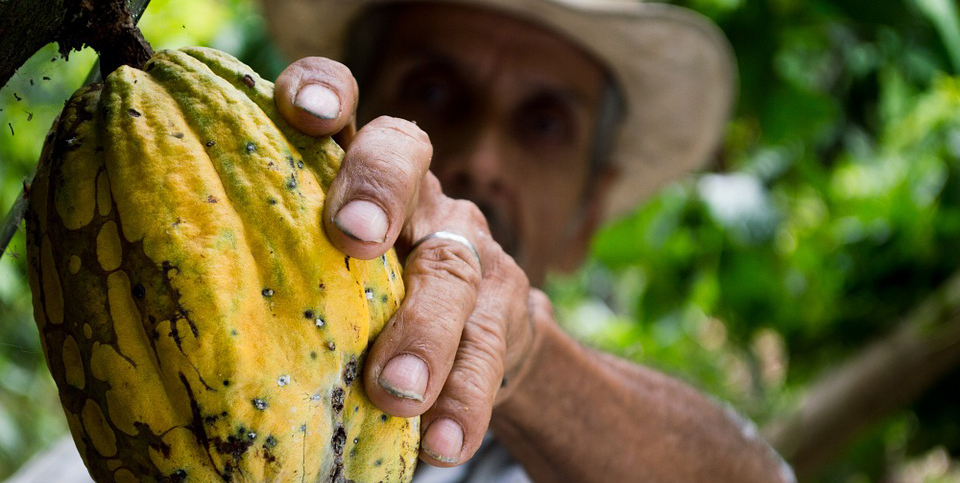Cutting out the middlemen and increasing local processing are commonly seen as the key to helping small producers capture more value and improve their incomes. Extracting oil instead of selling Brazil nuts, processing frozen fruit pulp instead of fresh fruit, making chocolate bars instead of cocoa beans – the finished product is clearly more expensive than the raw material. However, each also costs more to produce – more investment in equipment and technical capacity. So what does it take for those higher prices to actually translate into more profit or net income for producers?
Our second webinar in the “Forest Economies” Series took place on April 21, 2016, incorporating three different perspectives on the topic “From Raw Materials to Finished Product: Is it worth it for communities and small producers?” The panelists included Judy Logback, founder of Kallari Chocolates, Albert Bokkestijn from the Bosques Andinos Program, and Carla Morsello from the University of Sao Paulo. Judy and Albert spoke from their experiences implementing value-added production schemes with small producer associations, and shared key challenges and tips for those considering adding value to their raw materials.
To cap the conversation, Carla presented the results of her study on different productive strategies (with and without processing and with and without commercial alliances) and their impacts on forests and forest communities. Her research compared experiences with various non-timber forest products (açai, Brazil Nut, etc.), analyzing the impacts on communities’ net incomes, conservation (of forests and wildlife), and gender equality among others. Her findings challenged the conventional wisdom that more local processing and value always leads to better incomes and conservation outcomes for community producers.
Here, we condense the experts’ presentations down to 10 tips for knowing when processing and adding value is a good option for your product, and how to succeed if it is. You can find the recording of the full, Spanish-language webinar here, or join the conversation in our online forum with the panelists.

People
Relationships are clearly essential when forming productive associations, but its importance changes (although doesn’t weaken) when that association decides to take steps towards elaborating its own finished product. New relationships will need to be formed and old ones evolved. Here’s how to make sure they succeed:
1. Invest in building a strong organization, what Albert refers to as “social savings.” Judy explained that Kallari spent five years building the Association before selling its harvest, and that organization and communication are the first real strategic investments for any initiative.
2. Choose the right partners. Middlemen and trading partners can be key allies in providing services and accessing markets – or they can reduce the income that ultimately accrues to producers. Build transparent, trusting relationships with trading partners, built to last. Kallari farmers went from receiving $0.25 per pound of dried cocoa beans to $1.50 per pound when they cut out intermediaries and improved the quality of their fine aroma cocoa.
3. Diversify relationships. don’t depend on only one buyer or client.
4. Connect and Communicate. Connect with advisors and third parties who can guide and support you. Albert and Judy both emphasized that connections with expert advisers in your product are key to making sure it is at its best and for teaching you how to get there. Carla’s study revealed that, as opposed to those simply processing raw products, productive initiatives with commercial alliances established specifically to strengthen forest livelihoods and conservation are the ones that ultimately have the strongest positive impact on incomes, development and avoiding deforestation, while those without such alliances could actually see decreases in income.
5. But, the producers are the owners, their cultural and local knowledge is invaluable, and those external actors–while essential for their contacts and knowledge–are facilitators, not decision-makers. Judy explains that empowered producers that have a stake in, and see the results of, a more quality product seek more training, begin to innovate themselves, implement best practices and even transcend cultural barriers to connect to more markets.

Process
Is a community or association a good candidate for expanding into added value products? How do they start? What are the barriers and strategies to get around them? The experts share their take on the principal challenges and tips to overcome them:
[clear]
6. Know the market. Albert referenced thorough commercial research as one key to a successful processing scheme. Many projects struggle because they aren’t sufficiently aware of the market and of production costs.
7. Know your quantities. Some buyers will prioritize quantity over quality, while some will want the opposite. Judy and Albert recommend seeking out the latter, and Carla’s research illustrates the positive effect stable alliances with these buyers has on conservation and livelihoods. Yet Albert adds that it is equally important to evaluate how much producers can provide, and to then look for buyers seeking similar volumes.
8. Know your resources. Two major bottlenecks that Albert has observed for processing raw materials is limited access to the technology or credit necessary to manufacture high quality products,. Make sure you identify what your resources are for these crucial components in making your product before you take the plunge.
9. Keep learning. Kallari went through several stages and products before landing on chocolate, and even now are continuing to grow and evolve, hoping to have their own chocolate factory by 2020. Judy says that an essential part of their success is continually being open to new opportunities and connections.
10. Be patient. The journey is not only long, but can also be arduous. Problems will arise, and for those moments Albert shared his mantra: “Time and Tolerance,” while Judy offered a list of books to inspire initiatives to persist.
The next webinar in the Forest Economies series will take place in June, and will provide expert advice on how to participate in international fairs. Stay tuned for more details, and in the meantime join the conversation in our forum on adding value!
Recommended Links
[clear]





